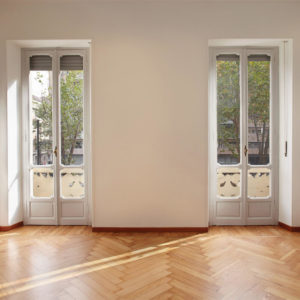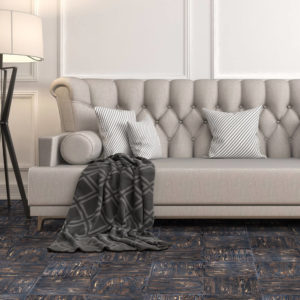If you’ve ever lived in a dormitory or a studio apartment, you know that there is a fine line between cozy and cramped. Choosing a wood floor for a small room presents a number of unique challenges. Because you literally have less room to work with, compromises between functional and aesthetic concerns are often necessary. How, then, do you choose design elements that you find interesting without creating visual clutter? Here are a few design tips to help you maximize the potential of any space.
 Color
Color
When choosing a color scheme, keep in mind this simple artist’s rule: cool colors recede and warm colors advance. There is a common misconception that dark wood floors should never be used in a small room as they cause it to feel cramped. While dark colors can make a room feel smaller, it is not true that dark woods should be avoided altogether.
If you love dark wood floors, offset them with lighter, cooler tones in your walls and furniture. The contrast of light and dark will be both visually striking and prevent the room from feeling claustrophobic. If you decide to go with medium to light shades for your floor, many interior designers suggest using similar colors for the walls. Using low-contrast colors eliminates the “horizon line,” creating the illusion of an expansive, unrestricted space.
Less Is More

When choosing a style of wood flooring for a small space, opt for wider planks as opposed to strip flooring. Fewer seams mean fewer lines, and so a room with wide planks will have less going on visually. Using a simple parquet pattern is another excellent way to keep your floor from appearing too busy. If you’re decorating adjoining rooms, use the same materials in both to avoid a patchwork look.
If the space is large enough that an inlay is appropriate, choose something that will draw interest to the floor, but that won’t be too much. Simple borders and accents can be an excellent way to make your floor visually stimulating. Plus, such ornaments tend to stand out even more when space is at a premium.
Create the Illusion of Space

Use Vertical Space
Room for practical necessities is more limited in smaller areas, so take advantage of empty walls. Hanging shelves and cupboards frees up floor space, and the more of your floor is exposed, the larger the room will feel. Of course, walls shouldn’t only be used functionally. An excellent way to create visual interest without creating clutter is to incorporate repeating motifs both horizontally and vertically. Using the same subtle border or accent pattern on both the floor and the walls can generate a dynamic unity while taking up very little space.
Consult a Professional
While it can be challenging to choose flooring and design elements for small spaces, the limitations can also offer sources for inspiration. The more creative a solution to a design problem is, the more memorable it is likely to be. One of the best ways to ensure that you get the most out of your space is to consult with a qualified designer. Many of the professionals at Oshkosh Designs have over 20 years of experience designing and handcrafting wood floors. And as all of our products are completely customizable, you can be certain of finding the right design for any home or professional space, no matter how small.

 Color
Color

